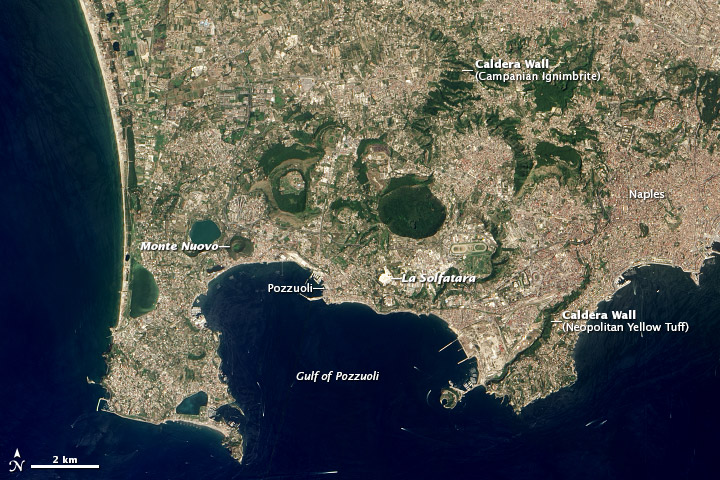Volcanologists report that Campi Flegrei , in and around which 1.5 million inhabitants live, is at the start of an eruption cycle
November 15th, 2018
The Campi Flegrei caldera cluster is the largest volcanic feature along the Bay of Naples, which is also home to the more famous Vesuvius. The Campi Flegrei, or “Fiery Fields,” is built from a series of overlapping volcanic features—calderas, domes, and cinder cones—that are historically active.
The Campi Flegrei calderas have produced two of the largest eruptions Europe has seen in the past 40,000 years. The Neopolitan Yellow Tuff (rock composed of fragments of material embedded within volcanic ash) was erupted roughly 12,800 years ago, with a total volume of at least 40 cubic kilometers (10 cubic miles). The Campanian Ignimbrite (rock made from the fused remnants of a pyroclastic flow) is about 32,800 years old and has a volume of at least 100 cubic kilometers (20 cubic miles).
Since the Neopolitan Yellow Tuff was formed, numerous small eruptions have occurred in the caldera complex, mostly less than half a cubic kilometer (0.1 cubic miles) in size. The most recent eruption occurred in 1538 at Monte Nuovo, a small cinder cone; that strombolian activity killed at least 32 people.
The most obvious manifestation of the magma under the surface at the Campi Flegrei is the La Solfatara, a region of intense hydrothermal activity. There has also been repeated cycles of uplift and subsidence near the city of Pozzouli, sometimes on the order of meters per decade, along with degassing within the Gulf of Pozzouli.
This natural-color image was acquired by the Advanced Land Imager (ALI) aboard the Earth Observing-1 (EO-1) satellite on July 9, 2012.
NASA Earth Observatory image by Jesse Allen and Robert Simmon, using EO-1 ALI data from the NASA EO-1 team. Caption by Erik Klemetti, Eruptions Blog/Denison University.


